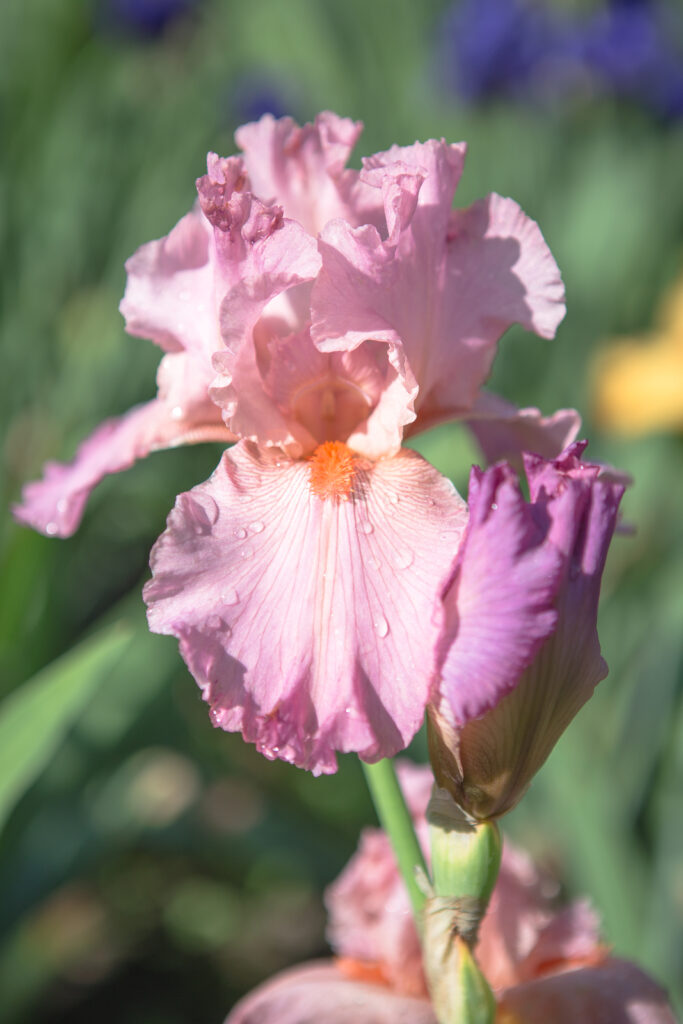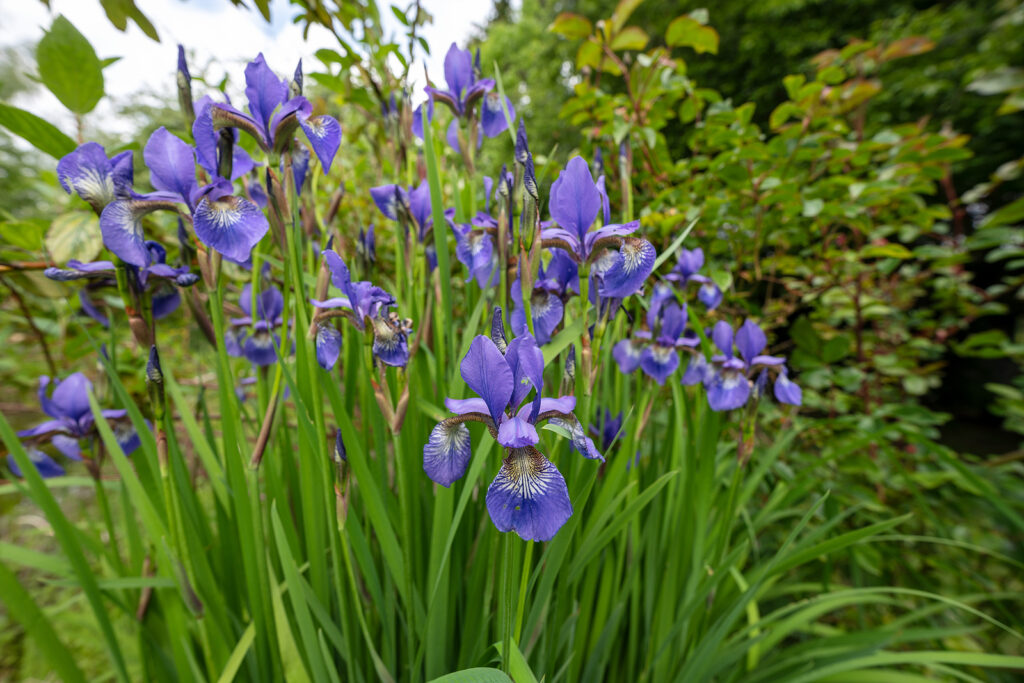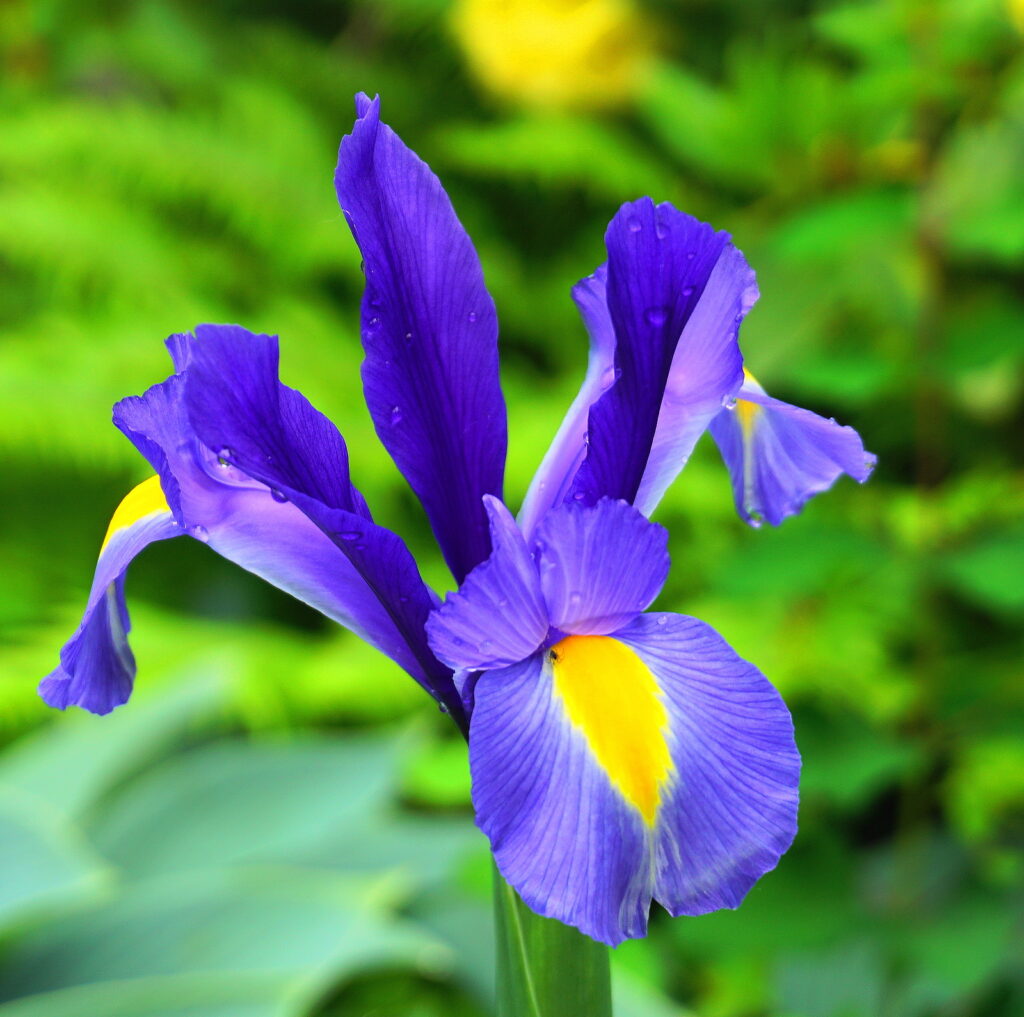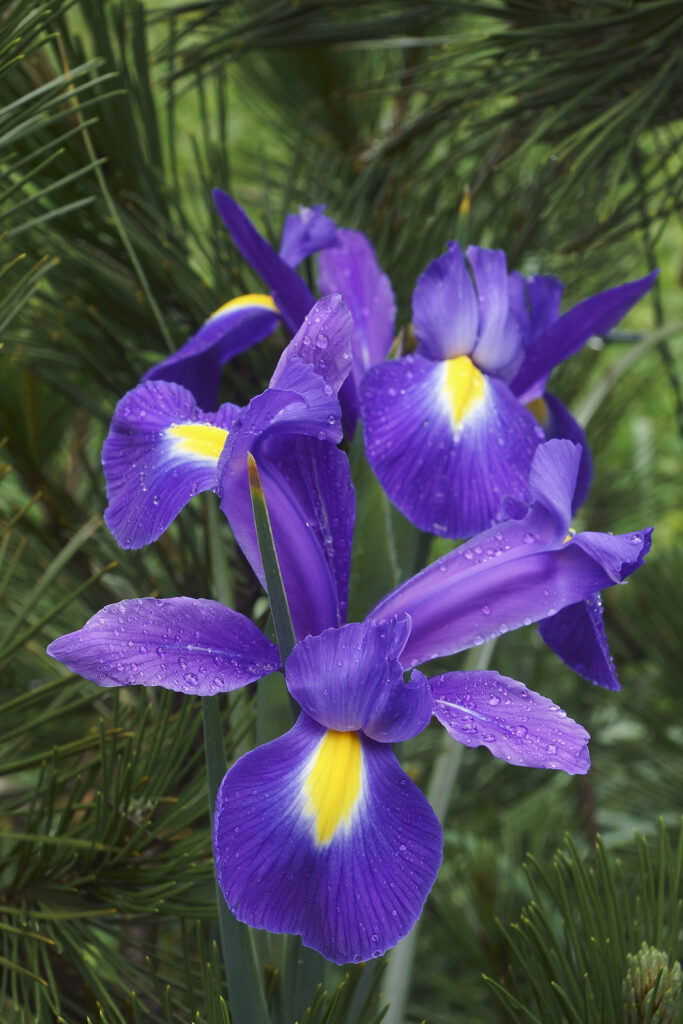Irises are the standouts of the spring garden. There are more than 300 species of irises. To risk oversimplifying this remarkably diverse group of plants: there are two types of iris flowers—bearded and beardless.
Tall bearded irises are widely grown and perhaps the most popular. They have showy flowers on branching stems from 28 to 48 inches (.7-1.2m) tall. The “beard” of the bearded iris extends below three upright and three horizontal petals. Bearded iris flowers come in every color except green and scarlet red.
Bearded irises bloom from early spring where winters are mild to early summer where winters are cold. There are smaller kinds of bearded irises—a variety of dwarf cultivars that range from 4 to 28 inches (10-71cm) tall.
Beardless irises distinguish themselves from bearded species by appearing “beardless”—there is no petal that falls below the horizontal petals as seen in bearded irises. There are five hybrid groups of beardless irises—Japanese irises, Louisiana irises, Pacific Coast irises, Siberian irises, and Spuria irises.
Beardless irises are widely planted in mass across landscapes.
Most irises grow from rhizomes; some grow from bulbs. All have straight, tall, sword-like grassy leaves.
Iris colors include white, ivory, shades of yellow, gold, apricot, orange, pink, magenta, maroon, brownish red, lavender, blues, purples, violets, and deep purple-black.
The requirements for growing an iris are simple–sun and good drainage. The plants grow well in almost any soil. They are less susceptible to disease in soils of moderate fertility.
Iris should not be crowded with other plants. It needs air and sunshine, but half a day of full sun will suffice.

Get to know Iris
- Plant type: Hardy or tender perennials
- Growing Zones and range: 3-10; species available for all zones
- Hardiness: Varies with species from very hardy to tender
- Height and width: 12 to 36 inches (30-91cm) tall
- Foliage: Leaves are long, narrow, and pointed.
- Flowers: Flowers consist of three upright petals called “standards” and three horizontal or drooping petal-like sepals called “falls’. Iris flowers are of two types: bearded in which a caterpillar-like “beard” extends onto the fall, and beardless.
- Bloom time: Early to midsummer in most regions, winter in Zones 10-11
- Uses: Beds, borders, containers
- Common name: German bearded iris, Siberian iris, Dutch iris
- Botanical name: Iris spp.
- Family: Iridaceae
- Origin: Mediterranean and Central Asia

Where to plant Iris
- Plant iris in full sun.
- Grow iris in humus-rich to average, well-drained soil.
- Prepare beds before planting adding aged compost and an all-purpose fertilizer

When to plant Iris
- Irises can be grown from rhizomes or seeds.
- Set iris rhizomes in the garden in spring or fall.
- Seed can be started in summer or fall in a nursery bed; start seed in a cold frame in late fall or winter.
- Set plants outdoors in spring after all danger of frost is passed; indoor started plants must be hardened off for several days before planting in the garden.

Planting and spacing Iris
- Start seed in small pots or flats; cover with 1/8 inch of soil. Seeds of hardy varieties should be pre-chilled for six weeks in the refrigerator.
- Seeds can take from one month to a year to germinate.
- Space rhizomes or divisions in the garden after all danger of frost has passed in spring. Plant iris 12 inches (30cm) or more apart. Rhizomes spread over time so allow room for spreading.
- Set rhizomes on a mound in a hole so that the flat top of the rhizome is level and horizontal to the soil with the roots down.

How to water and feed Iris
- Keep the soil evenly moist. Mature plants are drought-tolerant.
- Mulch around plants in dry weather to conserve soil moisture. Mulch with aged compost or chopped leaves.
- Fertilize the iris by adding all-purpose to the soil around plants in spring. Mulch with aged compost to feed the soil.
- Fertilize the iris a second time after blooming in summer.

Iris care
- Mulch around the iris to conserve soil moisture.
- Remove spent blossoms unless you want to collect seeds.
- Protect the iris in winter with lightweight mulch such as chopped leaves or pine needles. Pull back the mulch after all danger of frost ends in spring.
Growing Iris as a houseplant
- Iris danfordiae, Danford iris, and I. reticulata, netted iris, can be grown as houseplants.
- To force Iris to bloom, pot the bulbs in fall in a soilless medium with coarse sand added, setting the bulbs 2 inches deep and almost touching one another.
- Water well, and place the pots outdoors, either buried in the soil or protected in a cold frame, for six weeks to two months.
- If the temperature does not drop below 45F during this time, place the bulbs in a refrigerator. Ten set the pots in a cool room where light is direct and humidity is average to high.
- Keep the medium barely.
- Fertilizing is not necessary.
- After the flowers have faded, bulbs may be moved outdoors and planted in the garden but they cannot be forced a second time indoors.

Iris pests and diseases
- Iris may be attacked by aphids, spider mites, and root-knot nematodes.
- Rot and virus disease can occur.
Iris propagation
- Divide the bulbs or rhizomes after flowering. Discard the woody inner portion of the root clump and replant the outer portion.
- Divide bearded irises every 3 or 4 years.
- Divide beardless irises whenever clumps become crowded.
- To divide the iris: trim the foliage back to 5 inches (12cm) tall a day or two before dividing clumps. Dig up clumps being careful to avoid damaging the roots and rhizomes. Pull apart rhizomes so that each division has one or two fans of leaves and a good portion of the root. Replant immediately in well-prepared soil, a part of the rhizome should be above the soil. Newly divided plants will flower in a year or two.

Iris varieties to grow
- There are hundreds of iris cultivars. New varieties are introduced each year. Here are a few species:
- Dwarf iris (Iris cristata) grows to 6 inches (15cm) high with blue or white flowers; often used as a groundcover.
- German bearded iris (Iris germanica) includes both dwarf and tall types. The central arching “claw” consists of three central petals (standards) that rise from the blossom surrounded by three wide petals arching downward (falls), Each fall has a central furry strip or beard. Colors include white yellow, peach, brown, blue, and purple in many shades and combinations. The swordlike leaves are arranged in fans. This iris grows best in full sun and average, well-drained soil. It needs moderate moisture but is drought-tolerant once established in Zones 3-10.
- Japanese iris (I. kaempferi, I. ensata) is fibrous-rooted; this iris has large, flat flowers up to 10 inches (25cm) wide on branches and stems to 4 feet tall. The colorful flowers bloom once a year in early summer; flowers may be veined, marbled, or specked; all iris colors and red. Tolerates heat and humidity; a good choice for borders, water gardens, and naturalized meadows.
- Sweet iris (I. pallida) is an old-fashioned purple bearded iris with grey-green leaves; blooms in early summer; hardy in zones 3 to 7; some leaves are variegated yellow or white.
- Yellow flag (I. pseudacorus) is a yellow iris that resembles the Japanese iris; flowers are narrow and graceful; grows best in moist to wet soil.
- Siberian iris (Iris sibirica) is similar to the Japanese iris, fibrous-rooted, grows 2 to 4 feet tall; blooms after bearded iris and before Japanese iris; grows best in average, well-drained soil; tolerates both wet and moderately dry conditions in Zones 3-9.
- English iris (I. iphiodes) grows from bulbs; has narrow leaves with large blooms’ blooms a few weeks after the Dutch iris.
- Dutch iris (Iris xiphium) is grown as an annual in Zones 3-7 but is perennial in Zones 8-10; it requires humus-rich, well-drained soil. It is drought tolerant when dormant in summer. Leaves are tall and narrow; flowers are often used in bouquets; blooms are white, gold, bronze, blue, or purple.
Iris frequently asked questions
Q: How can I use irises in the garden?
A: There are many ways to feature irises in the garden. Include them in a perennial border or use them as single accents by themselves. Plant a clump of irises among evergreens. Interplant them with daylilies.
Q: What are the bloom times of various irises?
A: Irises will begin to bloom in early to mid-spring. Dwarf bearded irises will bloom in mid to late spring. Tall bearded irises and Siberian irises bloom from late spring into early summer. Dutch and Japanese irises bloom from early to mid-summer. Some bearded irises bloom a second time in late summer.
Q: Which irises bloom in shade?
A: Certain wild species of irises will bloom in partial shade: Iris cristta, I. gracilipes, I. verna, and I. foetidissima. Most irises prefer full sun.
Q: What is the best soil for irises?
A: Most irises want humus-rich, well-drained soil. Amend planting beds with organic matter such as peat moss, leaf mold, and aged compost before planting irises. Spade the bed deeply. Beardless irises and Japanese irises need plenty of moisture but not waterlogged soil. Louisiana irises and Iris versicolor can grow in wet soil.
Q: When is the best time to plant bearded irises?
A: Plant bearded irises after flowering in early to mid-summer. This will give them a long period of recuperation before blooming again the next year. They can also be planted in spring and fall. Plant rhizomes level with the surface in well-drained, sunny beds.
Q: When should I plant Japanese irises?
A: Plant Japanese irises in early spring before growth starts or in late summer. Set the crowns 2 inches below the surface.
Q: How do I plant Dutch, English, and Spanish irises?
A: Plant the bulbs four to five inches deep in mid to late autumn.
Q: What is the best spacing for irises?
A: Plant tall-bearded irises 9 to 18 inches apart; dwarf-bearded 6 to 9 inches apart; Japanese and Siberian 18 to 24 inches apart; bulbous 4 to 5 inches apart.
Q: How do I water irises?
A: Bearded irises usually need no watering, Japanese, Siberian, and other beardless types need plenty of moisture until they finish flowering. Cultivate them shallowly keeping the surface loose and free of weeds.
Q: How often should I transplant irises?
A: Transplant irises whenever they become crowded and the rhizomes are growing over one another–about every three years. Avoid moving bearded irises until after they bloom. Japanese and Siberian irises will bloom after being moved.
Q: How do I treat bearded irises after they bloom?
A: Remove the spent flower stalks immediately. Keep all the dead foliage cleaned off.
Q: How do I divide irises?
A: After bearded irises finish flowering, cut the leaves back halfway, lift the clumps, then cut the rhizomes into pieces with a sharp knife so that each has one strong fan of leaves. Division should be disease free. Japanese iris clumps are best divided with a heavy-bladed knife. Cut the leaves halfway back and then chop the rootstock into pieces each with three or four growths. Save only the vigorous portions.
Q: Why do my irises fail to bloom?
A: There are a few reasons irises fail to bloom: too much shade, alkaline soil, dry soil, waterlogged soil, and overcrowding. The more sun the better; divide plants every one to two years.
Also of interest:















